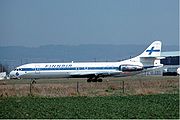
Thai Airways International Flight 601
Encyclopedia
Thai Airways International Flight 601 was a Sud Aviation Caravelle that crashed into the sea on landing at Kai Tak Airport
in a typhoon on 30 July 1967.
Flight 601 took off from Taipei Songshan Airport
(TSA/RCSS) on a flight to Kai Tak Airport
. The Sud Aviation Caravelle
(Registration: HS-TGI which had its first flight in 1960) had 73 passengers and 7 crew on board flight 601 and after a 1 hour flight was on an ILS approach to land on runway 31 at Hong Kong-Kai Tak International Airport (HKG/VHHH). With a typhoon over Hong Kong
at the time of the approach, the Captain was busy looking for visual contact with the ground not noticing that the aircraft had descended below the decision height of 415 feet. The aircraft made an abrupt heading change (while already 80 feet below the glide slope), then entered a high rate of descent and crashed into the sea short of runway 31 under-shoot. The accident killed 24 passengers out of 80 passengers and crew on board.

Kai Tak Airport
Kai Tak Airport was the international airport of Hong Kong from 1925 until 1998. It was officially known as the Hong Kong International Airport from 1954 to 6 July 1998, when it was closed and replaced by the new Hong Kong International Airport at Chek Lap Kok, 30 km to the west...
in a typhoon on 30 July 1967.
Accident
Thai Airways InternationalThai Airways International
Thai Airways International Public Company Limited is the national flag carrier and largest airline of Thailand. Formed in 1988, the airline's headquarters are located in Chatuchak District, Bangkok, and operates out of Suvarnabhumi Airport. Thai is a founding member of the Star Alliance. Thai is a...
Flight 601 took off from Taipei Songshan Airport
Taipei Songshan Airport
Taipei Songshan Airport or Taipei Sungshan Airport is a midsize commercial airport and military airbase located in Songshan, Taipei, Taiwan...
(TSA/RCSS) on a flight to Kai Tak Airport
Kai Tak Airport
Kai Tak Airport was the international airport of Hong Kong from 1925 until 1998. It was officially known as the Hong Kong International Airport from 1954 to 6 July 1998, when it was closed and replaced by the new Hong Kong International Airport at Chek Lap Kok, 30 km to the west...
. The Sud Aviation Caravelle
Sud Aviation Caravelle
The Sud Aviation SE 210 Caravelle was the first short/medium-range jet airliner produced by the French Sud Aviation firm starting in 1955 . The Caravelle was one of the more successful European first generation jetliners, selling throughout Europe and even penetrating the United States market, with...
(Registration: HS-TGI which had its first flight in 1960) had 73 passengers and 7 crew on board flight 601 and after a 1 hour flight was on an ILS approach to land on runway 31 at Hong Kong-Kai Tak International Airport (HKG/VHHH). With a typhoon over Hong Kong
Hong Kong
Hong Kong is one of two Special Administrative Regions of the People's Republic of China , the other being Macau. A city-state situated on China's south coast and enclosed by the Pearl River Delta and South China Sea, it is renowned for its expansive skyline and deep natural harbour...
at the time of the approach, the Captain was busy looking for visual contact with the ground not noticing that the aircraft had descended below the decision height of 415 feet. The aircraft made an abrupt heading change (while already 80 feet below the glide slope), then entered a high rate of descent and crashed into the sea short of runway 31 under-shoot. The accident killed 24 passengers out of 80 passengers and crew on board.

Probable Cause
The probable cause of the accident was crew error, not noticing that was aircraft descended below the glide slope. The presence of strong wind-shear and down-draughts is also a probable major factor, however at the time of the accident there was no means of measuring these phenomena available at Kai Tak.- The pilots did not adhere to the Thai Airways procedure for a 'captain monitored' approach in bad visibility.
- The captain did not monitor the approach adequately.
- The abrupt heading change after the aircraft descended below minimum altitude may have exacerbated a high rate of descent.
- Downdrafts and wind-shears may have contributed to the height loss which resulted from this mishandling.

